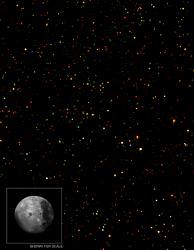 Each of the multicoloured dots in this photograph is a black hole. The panorama was created using images taken by NASA’s Chandra X-Ray Observatory, the Spitzer Space Telescope, and several ground-based telescopes. The scale image of the moon should give you an idea of how large a portion of the sky was imaged.
Each of the multicoloured dots in this photograph is a black hole. The panorama was created using images taken by NASA’s Chandra X-Ray Observatory, the Spitzer Space Telescope, and several ground-based telescopes. The scale image of the moon should give you an idea of how large a portion of the sky was imaged.
Each one of black holes in the picture is really the supermassive black hole that lies at the heart of another galaxy. Although the singularity itself is black, material chokes up around it, releasing the radiation we see. Astronomers call these active galactic nuclei, or AGNs.
This impressive new survey raises some doubts about what the environment around these black holes looks like. Astronomers used to think they were surrounded by a torus (or doughnut) of gas. This torus would block our view of certain kinds of radiation depending on its orientation. We should see some black holes unobscured, others partially obscured, and some completely obscured.
But instead of matching this prediction, the black holes are either completely visible, or totally obscured, and almost nothing in between. Astronomers will have to revise their models to better understand the environment around an actively feeding black hole.
Original Source: Chandra News Release
